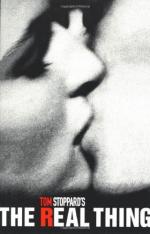|
This section contains 285 words (approx. 1 page at 400 words per page) |

|
The Real Thing Summary & Study Guide Description
The Real Thing Summary & Study Guide includes comprehensive information and analysis to help you understand the book. This study guide contains the following sections:
This detailed literature summary also contains Bibliography and a Free Quiz on The Real Thing by Tom Stoppard.
From the overnight sensation of Rosencrantz and Guildenstern Are Dead (1966) to the recent success of his script (with Marc Norman) for Shakespeare in Love (1998), Tom Stoppard has been acclaimed as one of the most important dramatic writers of the late-twentieth century. The Real Thing was first produced in 1982 on London's West End, and the cast included Roger Rees and Felicity Kendal (who subsequently became Stoppard's second wife). Its commercial and critical success was followed two years later by a sell-out production on Broadway in New York, with Glenn Close and Jeremy Irons in the main roles. That production won several Antionette "Tony" Perry Awards.
The play focuses upon Henry, who, much like Stoppard, is a successful playwright. Henry is married to an actress, Charlotte, who is playing the lead in his current play; he has fallen in love with another actress, Annie, for whom he soon leaves Charlotte. But is his new love "the real thing?" Underlying the major themes of love and adultery are related concerns. Does art influence life? Can life imitate art (the converse of the pro verb "art imitates life")? Must art have a political and social value, as many people in Britain were then arguing, or can it stand alone, as art for art's sake? Stoppard argues that intellectuals are taking political expression for literature, and he makes a strong case that art should be valued for its aesthetic merits alone.
Audiences in the 1960s and 1970s delighted in Stoppard's wit and cleverness, although they occasionally questioned whether the playwright could apply his genius to real life problems such as love and passion. The Real Thing ended such speculation and confirmed Stoppard's reputation for stylistic experimentalism and innovation.
Read more from the Study Guide
|
This section contains 285 words (approx. 1 page at 400 words per page) |

|



